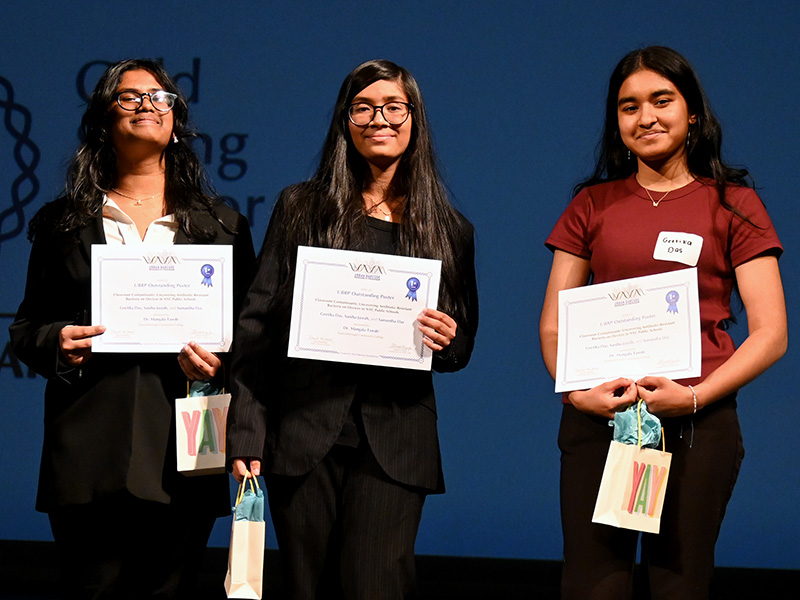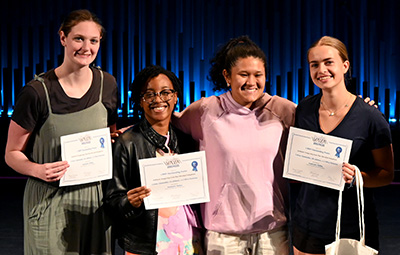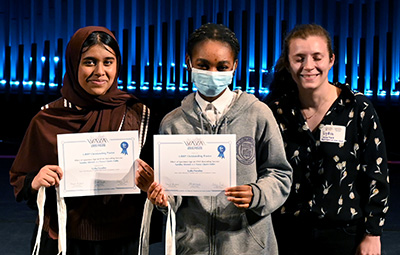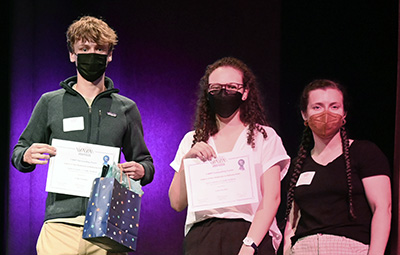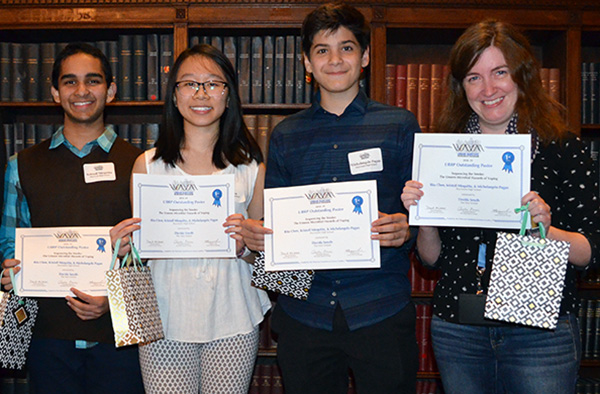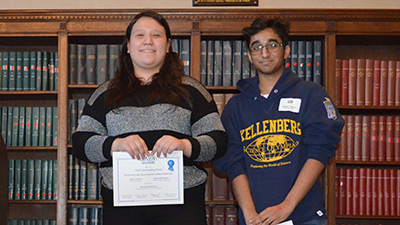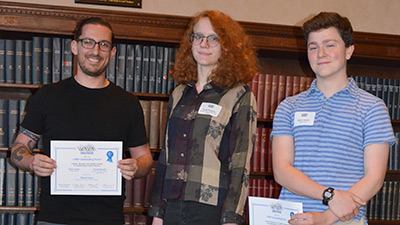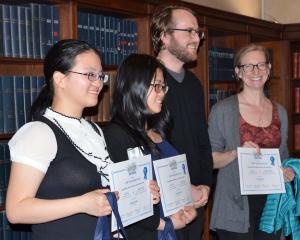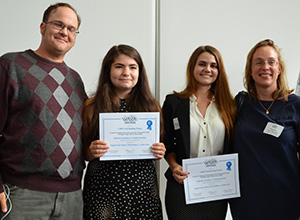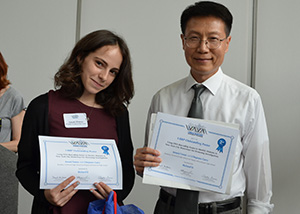Symposium: 2024 | 2023 | 2022 | 2021 | 2019 | 2018 | 2017 | 2016 | 2015 | 2014
2024-25 Symposium
Thank you to all of the teams who submitted proposals, performed experiments, and presented project results at the poster sessions held at the Theater at City Tech on Tuesday, May 20, 2025
At a glance:
- 35 students
- 13 mentors
- 38 schools and institutions
13 DNA barcoding projects:
- 31% bacteria
- 23% fungi
- 23% vertebrate
- 23% invertebrate
- 8% plant
Keynote Address
From Microbes to Megafauna: The Role of Metabarcoding in Shaping Oceanography
Elizabeth Suter, Ph.D.
Associate Professor of Environmental Science
Molloy University
Outstanding Posters
Classroom Contaminants: Uncovering Antibiotic-Resistant Bacteria on Devices in NYC Public Schools
Geetika Das, Saniha Jasrah, Samantha Das
Mentored by Mangala Tawde, Queensborough Community College
The speed of microbial transmission has fascinated the scientific community as bacteria rapidly spread through human populations via fomites such as door knobs. Other fomites include electronic devices such as phones, tablets, laptops, and computers. This spread can be observed by examining the devices we regularly use, such as communal devices (i.e. library computers or school tablets). Many New York City public school students encounter these devices at school, enabling bacterial infection to spread quickly through student populations which impacts students’ ability to learn and function. In this research project we aim to examine shared electronic devices in NYC public schools by sampling the bacteria on the device surfaces, and testing their antibiotic susceptibility. The devices’ surfaces will be swabbed to collect, isolate and identify bacteria via DNA barcoding. Antibiotic susceptibility will be tested using the Kirby-Bauer assay. The results of this investigation will help
2023-24 Symposium
Thank you to all of the teams who submitted proposals, performed experiments, and presented project results at the poster sessions held at the Theater at City Tech on Wednesday, May 29, 2024 from 4:00-7:00 PM.
At a glance:
- 39 students
- 17 mentors
- 38 schools and institutions
17 DNA barcoding projects:
- 35% bacteria
- 18% plant
- 18% fungi
- 18% vertebrate
- 12% invertebrate
Keynote Address
DNA Barcoding, oh the places you'll go!
Stephen E. Harris, Ph.D.
Assistant Professor of Biology Purchase College, SUNY
Outstanding Posters
Unveiling the hidden: using de novo transcriptomics in barcode analyses and mitogenomic assemblage of unknown Andean velvet worms
Kenny Chen, Brooklyn Technical High School and Samin Ragib, Brooklyn Technical High School
Mentored by Genrietta Yagudayeva, St. John’s University
Peripatus, an evolutionarily significant genus of flatworms, are commonly found in low-altitude, humid areas such as tropical or temperate rainforests. Thus, those found in high altitudes like the Andes mountains provide a fascinating line of inquiry into their adaptive molecular evolution. Similar to our previous research, where we identified high-altitude adapted planaria of the genus Amaga and reconstructed its mitochondrial (mt) genome, phylogeny, and life history implications, in this project, we present a similar study of high-altitude adapted velvet worms. Using Next-Generation Sequencing (NGS), we TRIzol RNA-extracted, sequenced the transcriptome samples, and isolated the cellular respiration barcode gene, COX1, for further analyses. Our methods show a transcriptomic approach in reconstructing the mt-genome and phylogeny of an unknown velvet worm. We suspect that our sample is a potential brother species of Peripatidae's radiative evolutionary family that harbors Epiperipatus boilleyi bio-mimetic applications while presenting genetic data of similarly evolved species. Our findings connect with our prior research to holistically explain how these understudied and neglected Andean invertebrates adapt to such high altitudes to explain their adaptation and implications.
2022-23 Symposium
Thank you to all of the teams who submitted proposals, performed experiments, and presented project results at the poster sessions held at the Theater at City Tech on Wednesday, May 31, 2023 from 4:00-7:00 PM.
At a glance:
- 38 students
- 14 mentors
- 33 schools and institutions
14 DNA barcoding projects:
- 36% plants
- 22% invertebrates
- 21% microbes
- 7% fungi
- 7% lichen
- 7% vertebrates
Keynote Address
Autocatalytic Mutualisms and the Evolution of Biological Systems
David Kizirian, Ph.D.
Curatorial Associate, Department of Herpetology, Division of Vertebrate Zoology American Museum of Natural History
Outstanding Posters
Lily Johnson, Olivia Patterson, Denia Diaz, Celeste Giannoulias
Antibiotic Prospecting From Plant Microbial Endophytes
Celeste Giannoulias, The Brearley School, Lily Johnson, Eleanor Roosevelt High School, and Olivia Patterson, The Brearley School
Mentored by Jeanmaire Molina, Pace University, LIU Brooklyn, and Denia Diaz, Pace University
Antibiotics are substances that kill bacteria and reduce the spread of bacterial infections. Many antibiotics are derived from natural metabolites produced by bacteria and fungi. However, antibiotic resistance is a growing problem resulting in a shortage of effective antibiotics. The Small World Initiative (SWI) hopes to address this crisis by crowdsourcing antibiotic discovery in soil samples. Another untapped but potential source of antibiotics may be found in endophytes. Endophytes are mutualistic microbes which live in plant tissues and may promote plant growth as well as enhance plant immune responses. Following SWI protocol, we isolated bacterial endophytes fromplants known to have antibacterial properties and from the rare plant Rafflesia, whose microbiome is unexplored. We taxonomically identified 11 isolates by DNA barcoding. Unfortunately, none of the bacterial isolates were able to inhibit Staphylococcus epidermidis and Escherichia coli in our antagonistic assays. However, we found evidence in the literature that these bacteria we have isolated, or their close relatives, possess antibiotic activity. It is possible that the proper growth environment was missing for the antibiotic activity to be engaged. Regardless, our study has shed light on the diversity of plant bacterial endophytes, and how they may be explored as a resource for antibiotic prospecting.
Samiha Ahmed, Nana Opare-Addo, Lydia Paradiso
Effect of Specimen Age on DNA Barcoding Success
Samiha Ahmed, Manhattan Center for Science and Mathematics and Nana Opare-Addo, Brooklyn Latin School
Mentored by Lydia Paradiso, CUNY Graduate Center and New York Botanical Garden
Plant DNA is well preserved in herbarium specimen samples, making them suitable for molecular and phylogenetic studies. However, ancient plant DNA poses difficulties due to its fragmented nature; this is a result of the degradation that DNA undergoes and the subsequent damage from chemical and physical factors. With this in mind, we investigated how the age of herbarium specimens would affect the success rate of DNA Barcoding, using specimens of different ages from 7 different species. We were able to extract detectable amounts of DNA from all 42 specimens. We then amplified two DNA barcoding regions (rbcL and matK), using the polymerase chain reaction (PCR), and sequenced the samples that were successful. We obtained at least one of the barcoding sequences for 22 specimens, including all of the specimens less than 20 years old, as well as a few of the specimens collected over 100 years ago. We observed that although older specimens were generally less successful than newer ones, other factors—in addition to age—may affect sequencing success.
2021-22 Symposium
Thank you to all of the teams who submitted proposals, performed experiments, and presented project results at the poster sessions held at The City Tech Theater on Friday June 3, 2022 from 4:00-7:00 PM.
At a glance:
- 38 students from 18 high schools
- 18 mentors from 13 institutions
- 15 high schools
18 DNA barcoding projects:
- 39% microbes
- 33% plants
- 28% animals
Keynote Address
Disturbed and Diverse: NYC microbial communities have elevated levels of biodiversity
Theodore Muth, Ph.D.
Professor, CUNY Brooklyn College
Outstanding Posters
Analysis of Moss Biodiversity in Manhattan Parks
Sadie Waldron and James Cannon; Manhattan Center for Science and Mathematics
Mentored by Lydia Paradiso, CUNY Graduate Center and New York Botanical Garden
Mosses are small, spore-bearing land plants which are an important component of ecosystems. Our study examines moss biodiversity in NYC parks, based on levels of human disturbance. We sampled 43 mosses from 3 sites: 97th Street Transverse (high disturbance, 14 samples), north Central Park (medium disturbance, 13 samples), and Inwood Hill Park (low disturbance, 16 samples). DNA barcodes for the plastid gene rbcL were sequenced for 37/43 samples (86%). Samples were identified using BLAST results for barcode sequences, suggestions from the iNaturalist computer vision model, and morphology. We identified 77% of the specimens to the genus or species level. We found mosses from 15 different genera, with the highest number of unique genera in the site with the lowest disturbance. However, more sampling is needed to examine the relationship between human disturbance and moss biodiversity. We concluded that DNA barcodes and iNaturalist are valuable tools for identifying mosses.
2020-21 Symposium
Thanks to all of the teams who submitted proposals, performed experiments, and presented project results at the Virtual Symposium on Wednesday, June 1, 2021.
At a glance:
- 19 participating teams
- 34 students
- 19 scientists
Keynote Address
Understanding, deconstructing and rebuilding microbiomes to make a better world
Javier A. Izquierdo, Ph.D.
Associate Professor of Biology, Hofstra University
2019-20 Symposium
The ninth year of the Urban Barcode Research Program concluded on Thursday, June 4, 2020 during a Virtual Symposium.
At a glance:
- 17 participating teams
- 34 students
- 17 scientists
Keynote Address
How I became a rainforest explorer: Ant genomes to microbiomes
Corrie S. Moreau, Ph.D.
Moser Professor of Arthropod Biosystematics and Biodiversity and curator of the Cornell University Insect Collection (CUIC)
2018-19 Symposium
The sixth year of the Urban Barcode Research Program concluded on May 30, 2019 with poster presentations at the New York Academy of Medicine, New York. Supported by The Pinkerton Foundation & Science Sandbox.
At a Glance:
- 20 participating teams
- 42 students from 13 high schools
- 20 scientists from 11 institutions
Taxonomic Group Studied:
- 45% Animals
- 40% Microbes
- 10% Plants
- 5% Other
Students collected 500+ samples, an average of 25 samples per team. Traditional DNA barcoding methods produced 520+ sequence reads, and next-generation sequencing methods generated more than 6.2 million sequence reads.
Keynote Address

Wild Microbes
Claudia Wultsch, Ph.D.
Hunter College, City University of New York
Sackler Lab of Comparative Genomics, American Museum of Natural History
Jaguar Program, Panthera
Outstanding Posters
Sequencing the Smoke: The Unseen Microbial Hazards of Vaping
Kristoff Misquitta, Michelangelo Pagan, and Rita Chen; Stuyvesant High School
Mentored by Davida Smyth, The New School.
E-cigarettes are rapidly rising in popularity among young adults. While the dangers of the aerosols produced by e-cigarerres are well-established, the risks posed by the cartridges themselves–shared among peers and infrequently cleaned–remain unexplored. Students analyzed the diversity and potential virulence of bacteria isolated from e-cigarette cartridges, users’ noses, and a control group of non-users’ noses. Bacteria present on cartridges and nasal swabs were isolated using selective and differential agar plates. The microbiome of each sample was also determined by 16S rRNA sequencing. While few colonies were isolated from the cartridges, several colonies were observed on agar plates from user and non-user noses. Bioinformatic analyses revealed that the nasal bacteria of users and non-users were similar to each other but distinct from the microbiomes of the cartridges, implying that e-cigarette surfaces may not contribute to bacterial transmission.
2017-18 Symposium
The fifth year of the Urban Barcode Research Program concluded on May 24 with poster sessions at the New York Academy of Medicine, New York. Supported by The Pinkerton Foundation & Science Sandbox.
At a Glance:
- 20 participating teams
- 40 students from 26 high schools
- 20 scientists from 11 institutions
Taxonomic Group Studied:
- 55% Animals
- 25% Microbes
- 20% Plants
Students collected 500+ samples, an average of 25 samples per team. Traditional DNA barcoding methods produced 2500+ sequence reads, and next-generation sequencing methods generated more than 100 million sequence reads.
Keynote Address
An Ecosystem in a Drop of Water: Molecular Approaches to Surveying Aquatic Biodiversity in Urban Habitats.
Elizabeth Alter, Ph.D.
Assistant Professor
Marine Evolutionary & Ecological Genetics
York College and The Graduate Center, CUNY
Outstanding Posters
Elizabeth Argiro and Joshua Antony
Isolation, Identification, and Characterization of Novel Viral RNA Dependent RNA Polymerases for Use in Synthetic Biology
Joshua Antony, Regis High School, and Elizabeth Argiro, Hunter College High School. Mentored by Benajmin tenOever, Icahn School of Medicine at Mount Sinai.
In an effort to survey and isolate novel viruses, students sequenced RNA from a collection of arthropods found in the New York area. Students identified and named the novel Jiminy Cricket virus. The virus is composed of a positive-sense single-stranded RNA that encodes four putative open reading frames (ORF1-ORF4) and is related to members of the Negevirus group. RNA transfection of Jiminy Cricket virus into arthropod and mammalian cultures demonstrated limited replication only in arthropod cells, which is consistent with members of this virus group.
Edward Myers, Nicole Kanzler, and Henry Kates
Sidewinders in Southwest America
Henry Kates, Trinity School, and Nicole Kanzler, Baruch College Campus High School. Mentored by Edward Myers, American Museum of Natural History
Crotalus cerastes is a species of rattlesnake native to the southwestern United States and northern Mexico. Three subspecies have been described, Crotalus cerastes cerastes, Crotalus cerastes cercobombus, and Crotalus cerastes laterorepens. However, subspecies are often classified based on color pattern and other superficial traits that may not represent the evolutionary history of the species. By obtaining DNA from samples of Crotalus cerastes and barcoding them, the students determined the genetic diversity of populations at varying levels of genetic and geographic interconnectedness. The findings suggested that both within the same subspecies and within the same general geographical area, there were significant enough genetic differences that distinct genetic groups could be identified. This implies that the way organisms are grouped into subspecies based on morphology may not be indicative of evolutionary history.
2016-17 Symposium
The fourth year of the Urban Barcode Research Program concluded on May 25 with poster sessions at the New York Academy of Medicine, New York. Funded by The Pinkerton Foundation.
At a Glance:
- 19 participating teams
- 39 students from 26 high schools
- 18 scientists from 15 institutions
Taxonomic Group Studied:
- 53% Animals
- 32% Microbes
- 5% Algae
- 5% Fungi
- 5% Plants
Students collected 600+ samples—an average 32 samples per team. Traditional DNA barcoding methods produced 1000+ sequence reads, and next-generation sequencing methods generated more than a million sequence reads.
Keynote Address
Some Adventures in Urban Barcoding
Jesse H. Ausubel
Director, Program for the Human Environment
The Rockefeller University
Outstanding Poster
Building a System of DNA Barcodes for Aquatic Species in the Bronx River
This project focused on building a system of DNA barcodes for the fish species in the Bronx River for further environmental research. We collected 11 samples and used two specific primer sets to target two mitochondrial loci, one on the COI gene and one in the 12S locus to amplify the DNA of our samples. 10 out of 11 samples were sent to sequence. However, only 6 samples had high quality DNA sequences that can be used for identification. This project can benefit scientists interested in exploring the fish species or the biodiversity in the Bronx River. Our follow-up project focuses on completing the DNA barcode data for the all fishes in the Bronx River and reporting new DNA sequences to the NCBI database.
2015-16 Symposium
The third year of the Urban Barcode Research Program concluded on June 3, 2016 with poster sessions at the Borough of Manhattan Community College, New York. Funded by The Pinkerton Foundation.
At a Glance:
- 20 participating teams
- 42 students from 24 high schools
- 19 scientists from 13 institutions
Taxonomic Group Studied:
- 35% Animals
- 30% Plants
- 20% Algae
- 15% Microbes
Students submitted 700+ samples for sequencing —an average 35 samples/team. Traditional DNA barcoding methods produced 1000+ sequence reads, and next-generation sequencing methods generated 1 million+ sequence reads.
Outstanding Posters
Pamela Stavrakos and Katherine Lamattina mentored by Eugenia Naro-Maciel, Seth Wollney, and John Davis
Ground Thruthing Environmental DNA Arthropod Profiles Through Single Species Barcoding
The major aims of this study are to 1) characterize aquatic invertebrate biodiversity in NYC, and 2) to compare and contrast DNA barcoding and eDNA metabarcoding approaches for revealing an ecosystem’s taxonomic profile. Additionally, we hope to 3) build a library of local genetic variants for Staten Island.
Using DNA Barcoding Assays to Identify Diatoms in New York City Waterways
Diatoms have been used in forensic investigations to determine if someone died from drowning. Our aim is to find out the most abundant diatoms at one location of New York City waterways. The results of this study can be potentially helpful in drowning investigations by law enforcement agencies.
2014-15 Symposium
Thanks to all of the teams who submitted proposals, performed experiments, and presented project results at the poster sessions held at the Linder Theater, American Museum of Natural History on June 15, 2015. Funded by The Pinkerton Foundation.
At a Glance:
- 20 participating teams
- 39 students from 21 high schools
- 17 scientists from 10 institutions
Taxonomic Group Studied:
- 55% Animals
- 20% Microorganisms
- 20% Plants
- 5% Fungi
Students submitted 600+ samples for sequencing – an average 30 samples/team. Traditional DNA barcoding methods produced 800+ sequence reads, and next-generation sequencing methods generated 1 million+ sequence reads.
Welcome & Student Presentation Part I
Student Presentation Part II
2013-14 Symposium
Thanks to all of the teams who submitted proposals, performed experiments, and presented project results at the poster sessions held at Kathryn W. Davis Teaching Classroom, American Museum of Natural History on April 29, 2014. Funded by The Pinkerton Foundation.
At a Glance:
- 20 participating teams
- 40 students from 17 high schools
- 16 public and 1 private
- 19 scientists from 12 institutions
Taxonomic Group Studied:
- 65% Animals
- 20% Microorganisms
- 15% Plants
Students submitted 500+ samples for sequencing – an average 27 samples/team. Traditional DNA barcoding methods produced 800+ sequence reads, and next-generation sequencing methods generated 600,000+ sequence reads.


